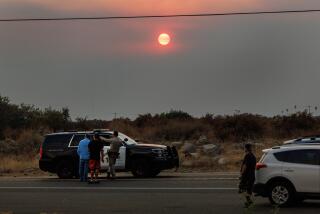Local Levels of Smog Show Decline for Year So Far : Pollution: There have been only 10 first-stage alerts. Experts credit the recent weather for the better-than-predicted air quality.
First it was too cool and damp for much smog, then too hot.
Both of those atypical weather patterns have thus far helped make 1994 even more smog-free than 1993, which had the fewest first-degree smog alerts ever recorded in the San Gabriel Valley.
There have been 10 first-stage smog alerts in the San Gabriel Valley so far this year, compared with 13 at this point last year, according to the South Coast Air Quality Management District.
Meteorologists begin tracking yearly smog levels every January, but the real smog season is May through October.
This May, unseasonable cloudiness blocked the sun’s rays, which normally intensify smog by trapping it, lid-like, with its heat, said Bill Kelly, AQMD spokesman. And rain cleared some of the pollutants from the air.
On the flip side, the last two weeks in June were unusually hot, exceeding 100 degrees in several San Gabriel Valley cities. Although meteorologists warned residents of approaching first-stage smog alerts, the temperature grew so hot in the valley that the ground air rose, punching through the inversion layer and releasing much of the smog, Kelly said.
Of the daily smog alerts expected June 22 to 29, only one, on June 24, materialized, said Joe Cassmassi, senior meteorologist with the AQMD. “We weren’t expecting that kind of heat so early in the season,” he said.
A first-stage smog alert is issued when the ozone exceeds 0.20 parts per million in any of the three local cities measured--Glendora, Pomona or Pasadena. On those days, everyone is advised to refrain from vigorous activity outside, and people with heart or lung problems are urged to spend as much time indoors as possible.
Meteorologists generally have expected this year’s smog levels to be higher than last because the El Nino weather conditions that kept smog to a minimum in 1993 have vanished. There were 19 first-stage alerts in 1993.
But the weather in the past two months has been so out of character for the region that meteorologists no longer know what to expect for smog levels this year, Kelly said.
The number of unhealthful days, when the ozone exceeds 0.12 parts per million, has zig-zagged over the past few years, higher in 1990 and 1992, lower in 1991 and ’93.
Regardless of whether this year is slightly more or less smoggy than last, AQMD meteorologists say air pollution is declining on the whole because of tougher state laws on industries that emit pollutants, said Claudia Keats, an AQMD spokeswoman.
In order to tally alerts and unhealthful days for the valley, the AQMD uses the numbers from whatever station has the worst record--typically Glendora.
The valley has not had a second-degree smog alert, issued when the ozone exceeds 0.35 parts per million, since 1986, Kelly said.
Clearing the Air
Annual number of first/second degree smog alerts:
1984 1985 1986 1987 1988 1989 1990 1991 1992 1993 POMONA 30/0 32/0 24/0 16/0 16/0 10/0 12/0 8/0 10/0 6/0 PASADENA 49/0 41/1 33/0 15/0 18/0 17/0 7/0 10/0 10/0 5/0 GLENDORA 67/0 68/5 70/1 51/0 54/0 37/0 29/0 34/0 30/0 19/0
Annual number of days with unhealthful air quality:
1984 1985 1986 1987 1988 1989 1990 1991 1992 1993 POMONA 98 98 89 72 91 61 60 60 56 45 PASADENA 125 116 110 95 119 80 69 70 71 53 GLENDORA 130* 141 148 135 148 121 103 91 118 96
Maximum ozone levels recorded since 1955:
POMONA: .49 parts per million in 1968
PASADENA: .54 parts per million in 1960
GLENDORA: .49 parts per million in 1980, the first year measurements were taken there *Less than 12 full months of data Source: South Coast Air Quality Management Districts
More to Read
Sign up for Essential California
The most important California stories and recommendations in your inbox every morning.
You may occasionally receive promotional content from the Los Angeles Times.










